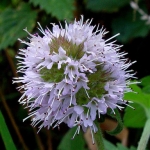| Common Name: |
Corn Mint |
| Other Names: |
Field Mint |
| Botanical Name: |
Mentha arvensis syn. M. austriaca. |
| Genus: |
Mentha |
| Family: |
Lamiaceae |
| Location: |
Europe, N Asia, and the Himalayas to Japan |
| Cultivation: |
Rich, moist soil in sun or partial shade. Mentha aquatica thrives in wet soil and M. arvensis tolerates dry conditions. Mentha pulegium prefers damn, sandy, acid soil; M. requienii needs moist shady conditions. Foliage may damaged by mildew and rust, though M. x villosa var. alopecuroides is resistant to rust. Most mints are invasive and are best grown in confined space. Mentha pulegium is a protected species in parts of Europe, and subject to statuatory control as a weed in some countries, notably in parts of Australia. |
| Propagation: |
By seed sown in spring (M. pulegium, M. requienii, M. satureioides only); by division in spring or autumn; by tip cuttings during the growing season, placed in moist soil mix or water (not M. requienii). Mentha requienii usually self sown self-sows. |
| Harvest: |
Whole plants are cut as flowering begins, and leaves are cut during the growing season, and used fresh or dried for use in concentrated waters, infusions, liquid extracts, powders, spirits, or oil distillation. Mentha arvensis is mainly decocted or powdered in Chinese remedies. |
| Height: |
10-60cm (4-24in) |
| Width: |
Indefinite |
| Variations: |
Banana
Is a French cultivar with a banana aroma |
Subsp. haplocalyx
syn. M. haplocalyx
(Chinese Mint)
Has a sweet scent, likened to heliotrope. |
var. piperescens
(Japanese Mint, Hakka)
Has ovate, gland-dotted leaves with a strong peppermint scent: |
var. Villosa
syn. M. canadensis
(American Mint)
Has lanceolate, hairy leaves, pink or white flowers; a pleasant aroma.
Height: 20-50cm (8-20in)
Width: Indefinite |
|
| Hardiness: |
Z6-9 |
| Parts Used: |
Whole plant,(bo he), leaves, oil. |
| Properties: |
A pungently aromatic, stimulant, anti-bacterial herb that benefits the digestion, relaxes spasms, reduces inflammation, and increases perspiration rate. It also relieves pain and itching, and suppresses lactation. According to Chinese medicine, it acts mainly on the lung and liver energies. |
| Medicinal Uses: |
Internally for colds, sore throat, headaches, measles, and indigestion; for nausea (var. villosa) by native N Americans. Externally for skin irritations. Combine with Chrysanthemum x morifolium (See, Florist's Chrysanthemum) and Schizonepeta tenuifolia in a powder for sore throat, blown down the throat through a tube. May reduce milk flow if taken when breast-feeding |
| Culinary Uses: |
Leaves used for flavoring and tea; traditionally used to prevent milk curdling. |
| Economic Uses: |
Source of Japanese mint oil (var. piperescens), used as a substitute for, or adulterant of, peppermint oil. |
| Bibliography: |
Encylopedia of Herbs by Deni Brown Copyright ©: 1995, 2001 Dorling Kindersley Limited pp.275-276
|

